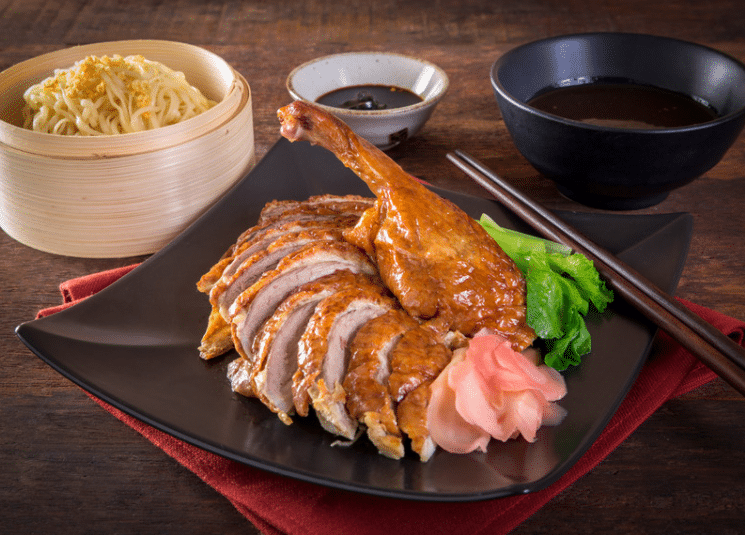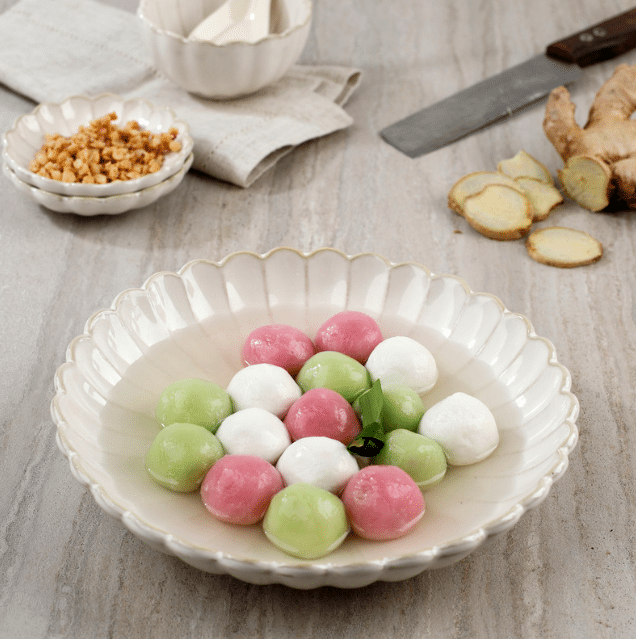China has a rich culinary history, with various delicious and healthy dishes served during the holidays. Fuel your love for learning Chinese at The Mandarin Show by trying traditional recipes this season! Chinese cuisine is diverse, with each region having unique flavors and specialties. So, put on your chef’s hat, and let’s get started!
Roast Duck
Roast duck is a must-have dish during the Chinese New Year festivities. It’s a flavorful and juicy roasted duck glazed with honey and soy sauce, giving it a sweet and savory taste. This dish is typically served with steamed buns, scallions, and hoisin sauce. Roast Duck is not just a delight for the taste buds but also holds significant symbolic value, making it a popular choice for the Chinese New Year feast. The duck, with its rich red meat, is seen as a symbol of fidelity and happiness.
and juicy roasted duck glazed with honey and soy sauce, giving it a sweet and savory taste. This dish is typically served with steamed buns, scallions, and hoisin sauce. Roast Duck is not just a delight for the taste buds but also holds significant symbolic value, making it a popular choice for the Chinese New Year feast. The duck, with its rich red meat, is seen as a symbol of fidelity and happiness.
Moreover, the duck’s long neck and wings are associated with unity and togetherness, which harmonize perfectly with the spirit of family reunion and shared prosperity that the Chinese New Year represents. Roasted duck is a popular dish in Chinese cuisine, with various derivatives found across the Asian continent. Yet, the Chinese version is the most sought-after one.
Jiaozi
Jiaozi is special in Chinese culture and traditions, particularly during the Chinese New Year and Winter Solstice. The bright and bold Chinese dumpling is filled with vegetables, pork, chicken, or beef. It’s made from a round wrapper filled with the ingredients, then sealed with unleavened dough, and finally steamed or boiled. Vinegar, soy sauce, and minced garlic typically accompany the dumplings.
Its popularity during these times is multifaceted, intertwining symbolic and practical reasons. From a symbolic perspective, the shape of Jiaozi resembles ancient Chinese money, known as ‘sycee’ or ‘gold ingots.’ Thus, eating Jiaozi is believed to bring wealth and prosperity in the coming year. Additionally, the preparation of Jiaozi is a communal activity, bringing families together on the eve of the New Year or Winter Solstice, reinforcing themes of unity and familial bonds. Therefore, this dish satisfies the palate and nourishes the spirit of togetherness and shared hopes for a prosperous future.
Tang Yuan
Tang Yuan is a sweet dumpling made from glutinous rice flour, pounded into tiny bowls, and filled with sweet sesame, red bean paste, or peanut butter. The Lantern Festival, which marks the end of the Chinese New Year celebrations, often calls for Tang Yuan. It’s a symbol of family reunion, as the dumplings represent the wish for a complete family gathering. It’s also said to bring good luck and prosperity in the coming year!
Yusheng
Yusheng is a salad dish popular in Singapore and Malaysia but originated in China. It’s a raw fish salad that’s typically eaten during the Chinese New Year, and the dish represents wealth and prosperity. The term Yusheng means “raw fish” in Chinese, and it’s said that the dish dates back more than 2000 years. The salad’s main ingredients include shredded raw fish, carrots, radishes, pomelo, and spices, decorated with various colorful vegetables like cucumber, peppers, and cilantro. The salad is then tossed high into the air, believing that the higher the toss, the more successful the coming year will be.
Niangao
Niangao is a popular snack and dessert during the Chinese New Year. It is a sweet, sticky cake made from glutinous rice flour, sugar, and sometimes red mung bean paste filling. The cake symbolizes the Chinese phrase “Nian Nian Gao Sheng,” which means “to have a prosperous year every year.” The pronunciation of the word “gao” is similar to the word for “high,” which is why people believe eating Niangao will bring good fortune and a high status in the coming year.
Culinary Tips
Chinese cooking may seem daunting to beginners, but with a few essential tips, you can bring the flavors of the East into your kitchen. Here are some pointers to help you embark on your Chinese cooking journey:
- Invest in a Wok: A wok is quintessential to Chinese cooking. Its concave shape allows for quick and even cooking, making it ideal for stir-frying, deep-frying, searing, and more.
- Use Fresh Ingredients: Traditional Chinese cuisine prioritizes fresh, quality ingredients. Ensure you’re sourcing the freshest produce and meats for your recipes for the most authentic flavors.
- Balance Your Flavors: Chinese cooking is all about balancing the five fundamental flavors: sweet, sour, bitter, spicy, and salty. When you create your dishes, strive for a harmony of these flavors.
- Understand Stir-Frying: Stir-frying is a cooking technique often used in Chinese cuisine. The key to perfect stir-frying is to cook on high heat and continuously move the ingredients around the wok to avoid burning and ensure even cooking.
- Handle Spices and Sauces Well: Chinese cuisine involves a variety of spices and sauces. Understanding how to use these can significantly enhance the flavor of your dishes. Some commonly used ones include soy sauce, oyster sauce, Szechuan peppercorns, and star anise.
- Patience is Key: Many Chinese dishes, especially soups and stews, require slow cooking over low heat to extract maximum flavor.
Remember, practice makes perfect! So, don’t get discouraged if your first few attempts don’t appear as expected. Keep experimenting and refining your techniques, and soon, you will be confidently creating delicious Chinese meals.
Get Cooking
Traditional Chinese recipes are a rich goldmine, with various flavors, textures, and ingredients representing Chinese culture, customs, and traditions. The dishes mentioned above are just a few examples of what Chinese cuisine has to offer, and you can find many more versatile options by exploring Chinese restaurants and markets. Trying out Chinese recipes can be a fun way to learn about Chinese culture and language, as you’ll learn essential cooking jargon and phrases that will help you communicate effectively in the kitchen. Surprise your friends and family with what you learn from The Mandarin Show! Happy cooking!


